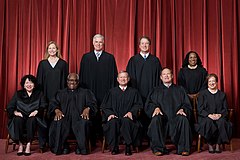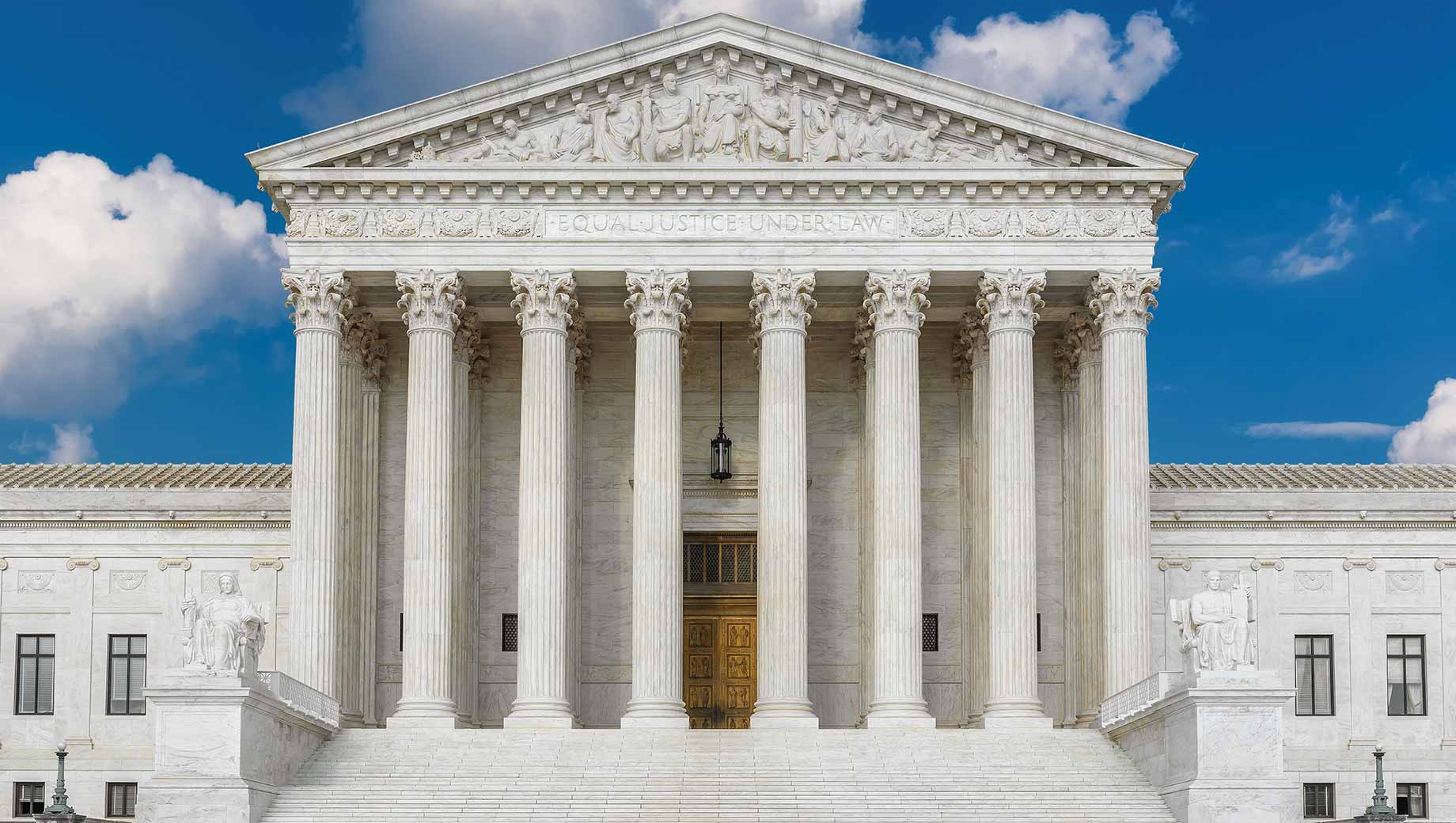The Supreme Court of the United States (SCOTUS) is the apex court of the federal judiciary of the United States. It deals with cases of appellate jurisdiction, cases dealing with constitutional/U.S. federal law interpretation, and original jurisdiction. It is an independent judicial body that has been empowered with judicial review, or the ability to strike down clauses, laws and amendments, should the court find them to be in violation of the Constitution. It was established on March 4, 1789, through the Judiciary Act of 1789.

As for the composition, SCOTUS currently consists of nine judges, including one Chief Justice. The judges have a life term. They can be impeached, but this is a difficult process. As such, the judges are only replaced when they retire or pass away, leading to very long effective terms for the judges. A new judge is put in place upon the nomination of the President with the advice and consent of the Senate, the upper house in the American legislature. The current Chief Justice is John Roberts, due to which the court is called the Roberts court.
The fact that the chief judicial officials are put in place by the executive (Senate confirmation tends to be ceremonial when the President’s and Senate majority parties are aligned) gives SCOTUS a political angle that is perhaps unheard of in other countries, like India.
Since SCOTUS is a powerful organization, both the Republicans and the Democrats want to “control” it. As such, whenever there is an opening for a SCOTUS judge, the sitting President usually appoints a judge who is aligned with his/her party’s ideology. In other words, a Republican President would likely nominate a conservative judge, while a Democratic President would rather nominate a liberal one. This also works in the other direction-a judge nominated by a party looks to retire when that party is in power, so his/her replacement keeps the same ideology.
The life term of the judges means very few Presidents get to nominate SCOTUS judges. However, this was not the case with former Republican President Donald Trump. The Republicans held a majority in Senate during his reign. President Trump got the opportunity to nominate three justices to the Supreme Court. These were Neil Gorsuch, Brett Kavanaugh, and Amy Coney Barrett. Two of these replaced either a liberal voter judge, or a swing voter judge.
Shrouded by political controversy, these replacements created an advantage for the conservative wing of SCOTUS. The Conservatives now outnumbered the liberals.
This has led to many left-wing oriented decisions of the past being overturned, and several new ones being made which are objectively right wing. Some of these will be discussed in the next section.
However, it is important to note that while there does seem to be a political bias in the supreme court, the judges labelled as “conservative” and “liberal” have not always voted against each other in blocs. The Chief Justice, John Roberts, although considered a moderate conservative has sided with the liberal judges on several occasions.
Cases recently decided/overturned by the Roberts Court, considered to be Conservative:

Roe v. Wade (overturned): Roe vs Wade was one of the most important judgements of the Supreme Court. It guaranteed a constitutional right to abortion in the United States. It was one of the most controversial judgements in the history of SCOTUS. It sparked a debate along partisan lines, one between religion and freedom. Some believed the court reached the wrong decision, others believed the right decision was reached in the wrong way. Nevertheless, the Roberts Court, in Dobbs v. Jackson Women’s Health Organization, the Roberts court overruled Roe and returned to states the authority to regulate abortion laws. It held that the U.S. constitution did not include the right to an abortion. The majority opinion, that is the one against abortion, was written by justice Samuel Alito. He is considered a staunch conservative and originalist, that is, he believes in the original meaning of the U.S. constitution rather than the living Constitution doctrine. A total of five judges voted to overturn Roe (notably, Roberts, the Chief Justice, took a more moderate position). Nevertheless, the overturning of Roe meant that several Republican states started restricting abortion to various degrees. The overruling was celebrated by the Republicans and criticized by the Democrats.

Students for Fair Admissions v. Harvard (and Students for Fair Admissions v. University of North Carolina): These companion cases represented a landmark decision in U.S. legal history and chose to outlaw all race-based affirmative action admission programs in university. These cases overturned Grutter vs Bollinger among others, which had validated the use of race in admissions so long as its role in the decision was “limited.” The argument used by the majority was that race-based affirmative action violated the Equal Protection Clause of the 14th Amendment to the U.S. Constitution. The Harvard case was decided 6-2, while the North Caroline one 6-3. In both cases, the majority opinion was given by John Roberts. The majority argued that the Equal Protection clause meant no difference due to race, color etc. and thus must apply to each person. It argued that “ending racial discrimination meant ending all of it”. In dissent, Justice Sotomayor wrote that “ignoring race will not equalize a society that is racially unequal.” Again, this was welcomed by the Republicans and opposed by the Democrats.

303 Creative LLC v. Elenis: This case was decided by the Supreme Court in 2023. It dealt with anti-discrimination laws in public spaces and the Free Speech clause of the 1st Amendment. The argument was whether a business owner could refuse to provide a service which went against their moral, personal, and religious values. In this particular case, it was about whether a website designer could refuse to provide a service that went against their personal religious beliefs, with reference to a same-sex marriage website. The Supreme Court, in a 6-3 decision, ruled in favor of the business. This decision, although seen to uphold the right to association, was widely criticized as it was reminiscent of race-based segregation present in the past in the U.S. It was seen as a setback for LGBTQ+ rights. The majority opinion was written by Neil Gorsuch, who held that “a businessperson cannot be compelled to create a work of art which goes against their values and which they would not produce for any client.” In dissent, Sotomayor said that the decision “grants a business open to the public a constitutional right to refuse to serve members of a protected class, and that, under the majority’s reasoning, stationers and photographers could be allowed to turn down clients on the basis of their sexual orientation or gender identity”. This decision was celebrated by the religious right, and staunchly criticized by the liberal left.
Several other cases have also been decided with a similar ideological background, such as the ones dealing with constitutional carry of firearms and President Biden’s student loan relief plan.
All in all, it seems like since three new conservative judges were only recently appointed, it will be very difficult to uproot the conservative nature of SCOTUS, given the nature of their terms. The Conservative SCOTUS is here to stay, and we may see more such stirring judgements in the future!
Note: I have taken the photographs/illustrations from internet. They belong to the author/photographer/designer of the original article/s.


this is so informative & well-written!
Thank you.
very clearly written and so important right now!
Thank you.
Very well written…….the concept of independence of judiciary as stated as one of the most important constitutional concept of US constitution… different case studies use to depict the influence of The Executive…
Thank you Ma’am.
Very enlightening write-up. It added to my knowledge.
Thank you.